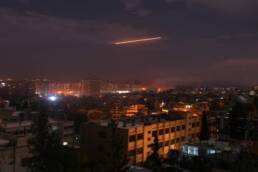Introduction:
Before counting the profits and losses, and whether the Russian military operation in Ukraine has ended the unipolar system of not, assuming that this is one of its objectives, the crumbling of US prestige in the streets of Kiev and the despicable performance of the Biden administration come to the surface, with the latter lacking any option before an inevitable Russian invasion into the heart of Ukraine. The French Foreign Minister Jean-Yves Le Drian seemed to be morning the US prestige while warning China, whom the looks are focused on, “not to get affected by what is going on in Ukraine and invade Taiwan.”
Until the moment of turning on the engines of the Russian tanks and launching them in an attack against East Ukraine and then to Kiev to depose its regime, the US and the West were ignoring the many lessons given to them about the threats that will be endured by whoever ventures to add Ukraine to the trenches of NATO, and the probabilities of war.
Ukraine, The Gateway of Europe into Russia … and Vise Versa
Sergei Blokhin, one of the most important professors of Ukrainian history in Harvard University, explains how Ukraine strategically represents Europe’s gateway into Russia, in addition to being the cultural and religious depth, and the heart of the Russian Empire. With the project of “Russian Revival” lead by Vladimir Putin over the past two decades, and the rehabilitation of Russia as a great power that is influential in international politics, Ukraine automatically regained the top priority on the Russian foreign agenda, not to reattach it to Russia, but rather to guarantee that it would not be transformed into its soft belly and into a playground for the West against it.
This was how George Kennan perceived what is going on the Russian -Ukrainian front, despite him being one of the engineers of the Cold War against the Soviet Union, and maybe because of that, for in the 1960s he warned of any attempt to expand eastward, favoring instead the strategy of containment from afar, so that Moscow would not be irritated and lead towards adopting military options as we are witnessing today. While the drums of war are deafening Europe, John Mearsheimer, a professor of political sciences and one of the fathers of realpolitik, presented an advice that was not taken into consideration, by which the US and its allies were supposed to relinquish their plans to integrate Ukraine into the West, favoring instead transforming it into a buffer zone between NATO and Russia.
However, all those warnings fell before the temptation of moving eastward and continue to encircle Russia by NATO especially through Ukraine as a stepping stone to infiltrate into Russia and play on dividing the Russian ethnic and religious diversity into sub-states, the way it happened with Yugoslavia, noting that all the documents of US intelligence, Strategic, and nuclear security issued in the past decade consider that Russia is the primary strategic and military threat to US hegemony on the international order, especially in light of Putin’s Doctrine, noting that Ukraine would be the last battleground for the West before reaching the Red Square in Moscow.
Ukraine Between Putin and Biden
Ukraine lies in the heart of President Vladimir Putin’s Doctrine according to which he sees a historical unity between Russia and Ukraine. In a study directed to the Russian armed forces, he saw that Russia should work on being a superpower, the way it was during the days of the Soviets, that it should participate in elaborating all international resolutions, and that it should establish alliances across the Atlantic, which means way beyond Eurasia which is considered as the most sacred part of the Russian strategic thinking.
The Russian demands, that are being discussed as one of the factors that bring it to the bring of war with the US and the west, are not new, as the Putin Doctrine included the necessity of preventing Ukraine from becoming a base for the NATO, and the necessity of the NATO forces to pull out from East Europe, away from the borders of the old Soviet Union, with Finland and Sweden committing to neutrality. These demands grant Putin the right of veto in the foreign policies of these countries, in order to protect Russian interests in the its historical sphere of influence.
On the Ukrainian front we see also present the doctrine of US President Joe Biden which comes in light of the tendency to dedicate all efforts to confront China, without forgetting the NATO expansion in Europe. The US pull out from Afghanistan has left a burning ball in the hands of the latter’s neighbors including China Russia and Iran, despite the scene of the humiliating and chaotic run away of US troops from Kabul airport. This US pull out, the way Biden wanted it, comes in line with the strategy of repositioning to confront the Chinese challenge in East Asia. With the ignition of the Ukrainian crisis, the US administration and the Biden Doctrine became in front of two challenges: To contain China in East Asia, and to keep pushing Russia away from the walls of the old Soviet Union, in an implementation of Brzezinski’s advice “if we want to get rid of Russia, we need to separate it from Ukraine.” Most probably, today this advice took advantage over all warnings, despite the stance of France, Germany, and Italy in 2008 against allowing Ukraine to join NATO, and to transform it like Poland and the Czech Republic into advanced lines of US attack against Russia, to deploy missile shields in it, while preventing it from becoming a nuclear power to avoid a nuclear war with Russia.
The Geostrategic option against the economic interests
Since the beginning of the crisis, the Russians showed in their maneuver in the Donbass that they are giving priority to the geostrategic option over any other option, while downgrading the urgent economic factor and the possible sanctions of the current confrontation, in order to use the strategic window that is still open to the military action, before Ukraine could join in the future the NATO and become under its nuclear cover.
On several occasions over the past few years, the Russians tested the limits of the Western reaction before heading to the Ukrainian front, and they failed all US preemptive plans to deter Russia through sanctions, which did not prevent them from annexing the Donbass, and then invading the whole of Ukraine. Hence, the economic sanctions did not witness a quality leap that could be a match to the Russian move, and countered the Russian invasion and annexation by disparate economic sanctions to join a list “that we prepared with our allies and partners against Russia in case it invades Ukraine,” according to the White House Spokesperson Jen Psaki.
The Russian Central Bank had increased its reserves after the West its sanction in 2014, and raised them to $670 billion that provide Vladimir Putin with enough time and tools to alleviate the effects of the sanctions on the Russian people, and continue the confrontation. This was added to the Chinese pledges to buy enough quantities of Russian gas, if the sanctions lead to shrinking the Russian share of the markets, in addition to China’s offering of full political and economic cover for the operation, according to the join Chines – Russian declaration, which is considered as one of the pillars of the current operation.
The US – Saudi crisis played an important role in neutralizing the arm of drowning the international markets with oil, which was used previously in collaboration with Riyadh after the Crimea crisis in 2014, to deprive Russia of its revenues, and to force it to accept extend the OPEC plus deal to cut on supply to stabilize the prices around $100 for the barrel. There are many signs that suggest that the US tried to anticipate the operation in Ukraine to liberate Europe from its addiction to Russian gas, in order to encourage it to go to a confrontation with Vladimir Putin and to partially or fully relinquish Russian gas. Hence, the Qataris did not respond to elevating them by the White House to the status of ally, by tendering any promise to Europe to supply it with liquid gas, due to their dependence on long term contracts in selling their production, and to the difficulty to cancel these contracts. This is at a time when the US failed to negotiate a deal with Total and Eni companies in Algeria and other states to form a gas cartel that is capable of substituting Russian gas, due to the retreat of Algerian reserves.
In this context, we can understand the renewed US attempt to demarcate the maritime borders between Lebanon and Occupied Palestine, the renewed US pressures on Lebanon to accept the US _ Israeli map, and the attempt to activate the gas network of the East Mediterranean forum and to link Europe to it in the future to replace the quantities of Russian gas.
The Limits of the imposed sanctions
The US administration have accumulated many indicators of retreat in front of Russia in Ukraine. In many other arenas that preceded it like in Crimea, the US sanctions did not lead to shake the Russians of their stances, despite the fact that Russia is confronting the sanctions that are the second hardest after Iran on the list of economic sanctions imposed by the US and Europe. The Cyber war that Russia is waging US sites, or its intervention in the US elections were not countered by an adequate reaction. The Russian opponent Alexey Navalny, planted by the US in Russia via the civil society and western media, did not become an explosive mine inside Russia, and was neutralized without any reliable US or European response. As for returning to the perform the role of the great power through the pipeline’s diplomacy, it has achieved great progress with Turkey via the South Stream, and in the Baltic and Germany and Europe via the North Stream. This is a strategy that led to more western addiction on Russian gas which represents 40 percent of European gas total consumption, without any prospects of being healed from this addiction. Most probably, Europe suffers from the Stockholm Syndrome with regards to Russia. This explains why Italy itself is struggling to prevent imposing sanctions on Russia, or to kick it out of the SWIFT system dominated by the US. In addition, the European Central Bank will not be in a comfortable position to manage the transactions in Euros with Russia. This is why its president Christine Lagarde opposes any financial sanctions on Russia until now, which will include the big European companies, and lead to slowing the European economy at a time when it is still suffering from the chaos of the lines of import and supplies of primary sources in light of the COVID-19 crisis, the inflation, and the rise in the prices of commodities. Despite the retreat of the Ruble against the US Dollar, which is still the strongest American arm, yet the efficiency of this arm might be limited in the Russian case due to the isolation of the Rubble from the international monetary system, and the fact that the Russian Central Bank does not own any US or national bonds, noting that the whole Russian banking system does not have foreign investments, while the Russian military – Industrial complex dominates the strategic oil and gas sectors.
Syria and the Ukrainian crisis
The Arrival of Russia’s Defense Minister Sergei Shoigu to Damascus in the middle of the crisis surprised many. Due to the Russian military deployment in the country, Syria might change from being a supporting country into a battleground, in case the crisis develops into an open miliary confrontation. After annexing Crimea, the US sanctions on Russia delayed its plans to develop its fifth fleet operating in the Mediterranean before the end of 2020, which made Russia rely more on Syria, and on its bases in Hmeimim and Tartus, where some of the ships of the Black Sea fleet are stationed. The Russians do not have a power that could match the Sixth US fleet, or NATO’s naval ships in the Mediterranean. This is why they heavily depend on their presence on the Syrians coasts to keep the Cyprus strait open for their ships, to protect their lines of communication with the Dardanelles and Bosphorus straits and the Black Sea, and exert pressure on the southern flank of NATO in case there would be a confrontation in Ukraine. During the past weeks, the Americans increased their naval presence in front of the Syrian coasts and deployed an Aircraft carrier, 12 destroyers, and a cruiser. On the other hand, the Russians deployed two nuclear submarines in addition to the cruisers Varyag and Marshal Ustinov, in addition to ten destroyers carrying ballistic missiles. The Russians also expanded Hmeimim’s runways to be able to receive the Tupolev 22 aircrafts and the MIG31s that are capable of carrying Kinzhal hypersonic missiles, so that they could test them in conditions that are different from Russia’s ones.
In light of the Ukrainian crisis, Syria has become the biggest military base out of the usual Russian military scenes. In this context, the Russians started for the first time since the eruption of war in Syria, to launch joint air patrols with the Syrian air force in the skies of the Golan, and on top of the ceasefire line with the Zionist enemy, which sees in this a huge change in the understandings with Russia in Syria, noting that Russia previously gave a blind eye on an attack on Latakia’s port, and on attacks against the positions of the axis of resistance in that country. During the past weeks, the Israelis started to feel that if Russia gets out victorious of the Ukrainian crisis, it will become stronger on the Syrian scene, which will limit Israel operations’ effectiveness in this country.
What Scenario to pull out of the crisis after the invasion of Ukraine?
The modest performance of the Ukrainian army did not surprise the military experts, because during the first 48 hours the Russians were capable of destroying the air bases and the networks of air defense, and were able to accomplish two naval landings in Mariupol and Odessa on the Black Sea, which made them link Crimea with their lands and control the coasts of the Black Sea, hence preventing the NATO fleets from reaching Ukraine. The mobilization of the strategic deterrence forces (Nuclear forces) aborted the possibility of a total war. And if President Vladimir Putin, or his enemies in the West, do not have yet any plan to pull out of the struggle in Ukraine, then it would be possible to talk about two possibilities for Ukraine to become a swamp that bleeds Russia economically and militarily in light of the refusal of the West to concede the guarantees requested by Russia to neutralize Ukraine.
The first scenario assumes the neutralization of the right wing and Nazi militias which grew extensively after bringing down the government of Victor Yanukovych that was supported by Russia in 2014. It is noteworthy that these militias received huge quantities of western weapons, under the pretext of arming the Ukrainian army. These weapons were meant to be used in guerilla warfare more than being meant for traditional regular combats, such as the Javelin anti-tank missiles, or the Stinger anti-aircraft missiles. In addition, we witnessed many western calls, especially from the UK and Denmark, to open the gate for “Ukrainian Jihad” for the extreme right and Nazi and Fascist groups in Europe. This scenario assumes the establishment of a pro-Russia government in Kiev, and will be very costly economically to Russia and entails providing huge financial and military support in light of the expected development of the sanctions that would drain off Moscow.
As for the second scenario, which is more likely, it assumes the pull out of Russian troops towards the regions in east Ukraine and on the coasts of the Black Sea, that are predominantly Russian speaking, and to divide Ukraine between regions that pay allegiance to Russia, and the rest of Ukraine that would be loyal to the West. This will transform Ukraine into a wretched and failed state, and will extend war in it, while exerting pressures on Europe by destabilizing the NATO countries west of Ukraine, such as the Czech Republic, Poland, and Romania which started to feel the pressure of the exodus of millions of Ukrainians.
Where is the World Order Heading?
The fate of the current World Order, and the rifts that hit the US hegemony on it, in addition to the wounds that undermined the US prestige, is linked to the elaboration of a multipolar order to the phase of existence by force and the full victory of Russia in Ukraine. this is a long process that still requires more Western divisions, and more tensions in East Europe. the economic cost for the West would increase in case the Russians revert to turning the table on everybody by stopping to pump gas in the arteries of the European economy, in addition to transforming Ukraine into a security, financial, and political liability on Europe, especially if the crisis extends and the lines of refugees running away from the Ukrainian hell increase. It is early to say what would be the structure of the new world order, as the US is still very strong and still has many options to escalate the confrontation. However, there is no doubt that the world is heading towards a new international balance of powers.
#caus #centre_for_arab_unity_studies #Nato_Russian_confrontation #Russia’s_military_powers #war_against_Ukraine #Russia_against_Ukraine #Nato #Russia
مركز دراسات الوحدة العربية
فكرة تأسيس مركز للدراسات من جانب نخبة واسعة من المثقفين العرب في سبعينيات القرن الماضي كمشروع فكري وبحثي متخصص في قضايا الوحدة العربية
We appreciate your support
SUPPORT THE CENTRE FOR ARAB UNITY STUDIES
The Centre is reaching out for its friends and readers for support, whether by ordering our publications and paying for them in hard currency, or through donations. The Centre welcomes any support to boost its resiliency, to ensure its survival, the continuation of its legacy and its commitment to tackle issues facing the Arabs and the Arab world.



